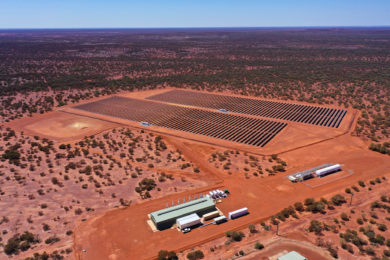Pacific Energy says it has successfully designed and delivered four industry-leading hybrid power systems for Westgold Resources Limited’s gold mining operations in Western Australia’s Mid West region.
The hybrid systems, which have a combined capacity of 82 MW, have been delivered under a seven-year build-own-operate agreement and comprise 28 MW of solar, 11.5 MW of battery energy storage (BESS) and 42.5 MW of high-efficiency gas generation.
The four systems, located at Westgold’s Tuckabianna, Bluebird, Fortnum and Big Bell facilities, were delivered concurrently and in parallel with Westgold’s operational expansion projects at all four sites. They replace six diesel-fired plants and are expected to collectively displace 38 million litres of diesel every year and cut carbon emissions by up to 57,000 t annually.
The Tuckabianna system, which was fully commissioned in August 2023, achieved an average of 31% solar penetration between November 2023 and January 2024, peaking at 36.9% in December.
Westgold’s Managing Director and CEO, Wayne Bramwell, said powering Westgold’s operations with renewables was at the heart of its Clean Energy Transition project, which is set to improve the company’s environmental efficiencies and reduce operating costs.
“Moving towards renewables works for Westgold as a business because it drives costs out,” Bramwell said. “It also works for the environment because it significantly reduces carbon emissions and it sends a signal about our long-term view of building a sustainable busines.”
Pacific Energy’s Chief Executive Officer, Jamie Cullen, said: “This complex project showcases Pacific Energy’s commitment to delivering sustainable, cutting-edge solutions for our clients, even in the very challenging circumstances we encounter in remote locations.
“Pacific Energy and Westgold have worked side-by-side in the Mid West’s tough environment to deliver these systems safely, with zero lost time injuries. And by delivering the hybrid systems concurrently, we’ve been able to identify different response scenarios at each location and implement those learnings across the board to optimise system capabilities.”
Pacific Energy centred the design of the hybrid systems around its virtual generator (VG) BESS technology, which integrates renewable energy sources and dynamically stabilises the power systems, marking a shift away from thermal generation as the primary source of system stability.
An evolution of grid forming BESS technology, VG BESS can mimic the characteristics of rotating thermal generators, providing for the first time the ability to stabilise large-scale power systems without burning fuel or using legacy technologies like synchronous condensers, according to Pacific Energy.
The new hybrid systems also have emergency hydrocarbons-off functionality, which enables mining operations using solar and BESS during system outages and other critical situations, it added.
Cullen said: “We’re approaching our systems design with a future-focused mindset, so they can support the increasing sophistication of renewable energy technologies for years to come, and to ensure we’re delivering the decarbonisation outcomes our clients are looking for.”










